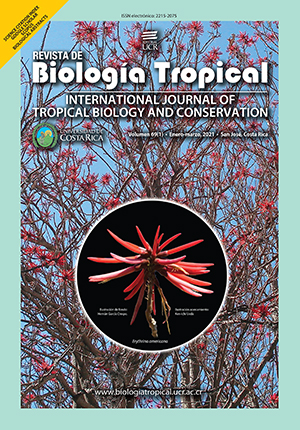Abstract
Introduction: The Panamic Cushion Star Pentaceraster cumingi is widely distributed along the Tropical Eastern Pacific. This species strictly produces only five arms, but sometimes, this number varies or show another kind of abnormality. Objective: We aimed to evaluate the population size structure and abnormalities occurrence in the radial pattern of P. cumingi in Bahía Chamela, Jalisco, Mexico. Methods: The population was monitored along four years (2016-2019), in two seasonal periods (warm and cold). During fieldwork, a random sample of individuals was collected. Every starfish was measured, weighted, and evaluated to identify any abnormality on its radial pattern. Results: The highest density of P. cumingi was found in October 2019 (2.03 ± 0.05 ind/m-2), the lower in March 2017 (0.66 ± 0.13 ind/m-2). A total of 849 individuals were collected. For 5-armed starfishes, the average length was 123.8 ± 15.2 mm and the average weight of 326.0 ± 62.4 g. The most frequent length classes ranged from 110 to 120 mm. Of the total of individuals sampled 0.82 % had four arms, 1.06 % six, and 1.41 % had one bifurcated arm. Conclusions: There were differences in the population density and size structure of P. cumingi between seasons. The main causes of abnormalities in the starfish could be due to the changes that occur during larval metamorphosis or by an abnormal regeneration of the arms after a predation attempt.
##plugins.facebook.comentarios##

This work is licensed under a Creative Commons Attribution 4.0 International License.
Copyright (c) 2021 Cristian Moisés Galván-Villa, M. en C., Francisco Alonso Solís-Marín, Dr







